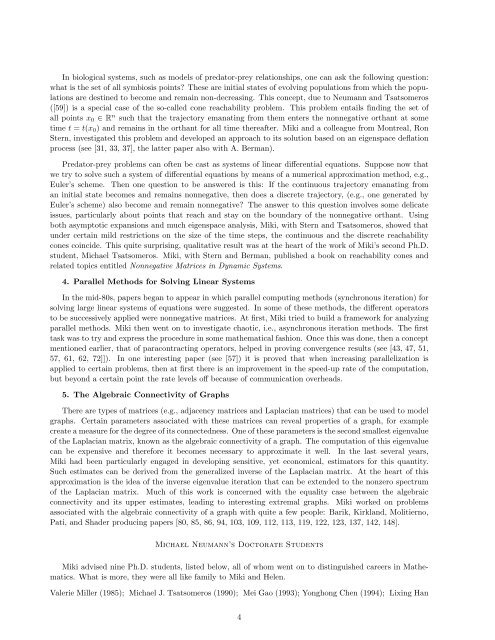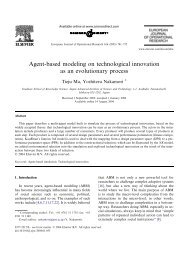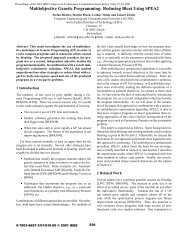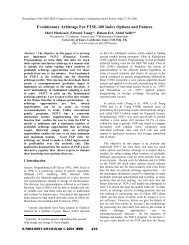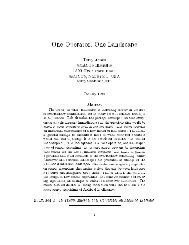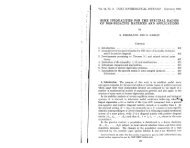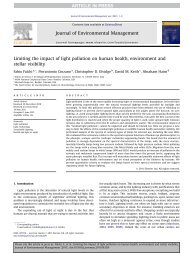In Memoriam Michael (Miki) Neumann (1946-2011)
In Memoriam Michael (Miki) Neumann (1946-2011)
In Memoriam Michael (Miki) Neumann (1946-2011)
You also want an ePaper? Increase the reach of your titles
YUMPU automatically turns print PDFs into web optimized ePapers that Google loves.
<strong>In</strong> biological systems, such as models of predator-prey relationships, one can ask the following question:<br />
what is the set of all symbiosis points? These are initial states of evolving populations from which the populations<br />
are destined to become and remain non-decreasing. This concept, due to <strong>Neumann</strong> and Tsatsomeros<br />
([59]) is a special case of the so-called cone reachability problem. This problem entails finding the set of<br />
all points x0 ∈ R n such that the trajectory emanating from them enters the nonnegative orthant at some<br />
time t = t(x0) and remains in the orthant for all time thereafter. <strong>Miki</strong> and a colleague from Montreal, Ron<br />
Stern, investigated this problem and developed an approach to its solution based on an eigenspace deflation<br />
process (see [31, 33, 37], the latter paper also with A. Berman).<br />
Predator-prey problems can often be cast as systems of linear differential equations. Suppose now that<br />
we try to solve such a system of differential equations by means of a numerical approximation method, e.g.,<br />
Euler’s scheme. Then one question to be answered is this: If the continuous trajectory emanating from<br />
an initial state becomes and remains nonnegative, then does a discrete trajectory, (e.g., one generated by<br />
Euler’s scheme) also become and remain nonnegative? The answer to this question involves some delicate<br />
issues, particularly about points that reach and stay on the boundary of the nonnegative orthant. Using<br />
both asymptotic expansions and much eigenspace analysis, <strong>Miki</strong>, with Stern and Tsatsomeros, showed that<br />
under certain mild restrictions on the size of the time steps, the continuous and the discrete reachability<br />
cones coincide. This quite surprising, qualitative result was at the heart of the work of <strong>Miki</strong>’s second Ph.D.<br />
student, <strong>Michael</strong> Tsatsomeros. <strong>Miki</strong>, with Stern and Berman, published a book on reachability cones and<br />
related topics entitled Nonnegative Matrices in Dynamic Systems.<br />
4. Parallel Methods for Solving Linear Systems<br />
<strong>In</strong> the mid-80s, papers began to appear in which parallel computing methods (synchronous iteration) for<br />
solving large linear systems of equations were suggested. <strong>In</strong> some of these methods, the different operators<br />
to be successively applied were nonnegative matrices. At first, <strong>Miki</strong> tried to build a framework for analyzing<br />
parallel methods. <strong>Miki</strong> then went on to investigate chaotic, i.e., asynchronous iteration methods. The first<br />
task was to try and express the procedure in some mathematical fashion. Once this was done, then a concept<br />
mentioned earlier, that of paracontracting operators, helped in proving convergence results (see [43, 47, 51,<br />
57, 61, 62, 72]]). <strong>In</strong> one interesting paper (see [57]) it is proved that when increasing parallelization is<br />
applied to certain problems, then at first there is an improvement in the speed-up rate of the computation,<br />
but beyond a certain point the rate levels off because of communication overheads.<br />
5. The Algebraic Connectivity of Graphs<br />
There are types of matrices (e.g., adjacency matrices and Laplacian matrices) that can be used to model<br />
graphs. Certain parameters associated with these matrices can reveal properties of a graph, for example<br />
create a measure for the degree of its connectedness. One of these parameters is the second smallest eigenvalue<br />
of the Laplacian matrix, known as the algebraic connectivity of a graph. The computation of this eigenvalue<br />
can be expensive and therefore it becomes necessary to approximate it well. <strong>In</strong> the last several years,<br />
<strong>Miki</strong> had been particularly engaged in developing sensitive, yet economical, estimators for this quantity.<br />
Such estimates can be derived from the generalized inverse of the Laplacian matrix. At the heart of this<br />
approximation is the idea of the inverse eigenvalue iteration that can be extended to the nonzero spectrum<br />
of the Laplacian matrix. Much of this work is concerned with the equality case between the algebraic<br />
connectivity and its upper estimates, leading to interesting extremal graphs. <strong>Miki</strong> worked on problems<br />
associated with the algebraic connectivity of a graph with quite a few people: Barik, Kirkland, Molitierno,<br />
Pati, and Shader producing papers [80, 85, 86, 94, 103, 109, 112, 113, 119, 122, 123, 137, 142, 148].<br />
<strong>Michael</strong> <strong>Neumann</strong>’s Doctorate Students<br />
<strong>Miki</strong> advised nine Ph.D. students, listed below, all of whom went on to distinguished careers in Mathematics.<br />
What is more, they were all like family to <strong>Miki</strong> and Helen.<br />
Valerie Miller (1985); <strong>Michael</strong> J. Tsatsomeros (1990); Mei Gao (1993); Yonghong Chen (1994); Lixing Han<br />
4


